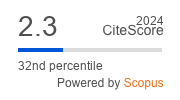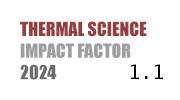ABSTRACT
Automotive air-conditioning systems (AACs) traditionally use high-GWP refrigerants, raising environmental concerns. To address this, new azeotropic refrigerant blends-R513A, R513B, R515A, R515B, and R516A-have been developed. These blends offer environmentally friendly alternatives with promising thermodynamic performance. R513A and R513B are suitable replacements for R1234yf and R134a with minimal system modifications, while R516A provides the highest cooling capacity (16.54 kW) and maximum optimal COP (39.84), making it highly effective. R515A ensures low GWP and compressor temperatures, whereas R513A and R513B optimize energy efficiency and safety. Notably, R513A and R513B exhibit the lowest compression ratio (γ) and highest COP values (5.79, 7.23, and 9.40) across various evaporator temperatures, making them ideal for energy-saving applications. Overall, azeotropic refrigerants outperform R1234yf in COP, cooling capacity, and safety, while offering environmentally sustainable solutions for AACs.
KEYWORDS
PAPER SUBMITTED: 2025-04-11
PAPER REVISED: 2025-05-20
PAPER ACCEPTED: 2025-05-26
PUBLISHED ONLINE: 2025-07-05
- UNEP, United Nations Environment Programme, Montreal Protocol on Substances that Deplete the Ozone Layer, Final Act. United Nations, New York, 1987
- GCRP, Global Environmental Change Report, A brief analysis kyoto protocol, 1997
- UNEP, United Nations Environment Programme, Twenty-eighth meeting of the parties to the Montreal Protocol on substances that deplete the ozone layer, Decision XXVIII/Further Amendment Montreal Protocol, 2016, pp. 1-9
- Khalid A. J., et al., Experimental and computer performance study of an automotive air conditioning system with alternative refrigerants, Energy Conversion and Management, 44 (2003), 18, pp. 2959-2976
- Baskaran A., Koshy P., Mathews, A Performance Comparison of Vapour Compression Refrigeration System Using Eco Friendly Refrigerants of Low Global Warming Potential, Engineering, Environmental Science (2012)
- Yohan L., et al., Performance of virtually non-flammable azeotropic HFO1234yf/HFC134a mixture for HFC134a applications, International Journal of Refrigeration, 36 (2013),14, pp. 1203-1207
- Ioan S., A review on substitution strategy of non-ecologicalrefrigerants from vapour compression-based refrigeration,air-conditioning and heat pump systems, International Journal of Refrigeration, 46 (2014), pp. 123-141
- Adrián M., et al., Experimental assessment of R134a and its lower GWPalternative R513A, International Journal of Refrigeration, 74 (2017), pp. 682-688
- Uwadiae M. E., et al., Experimental Investigation of R-134a And R 600a Refrigerant Blend In Domestic Vapour Compression Refrigeration System, Nigerian Journal of Technology (NIJOTECH) 36 (2017), pp. 1138 - 1144
- Daviran S., et al., A comparative study on the performance of HFO-1234yfand HFC-134a as an alternative in automotive air conditioning systems, Applied Thermal Engineering, 110 (2017), pp. 1091-1100
- Yang M., et al., Experimental study on R1234yf/R134a mixture (R513A) asR134a replacement in a domestic refrigerator, Applied Thermal Engineering, 146 (2019), pp. 540-547
- Mota-Babiloni A., et al., Experimental exergy analysis of R513A to replace R134a in a small capacity refrigeration system, Energy, 162 (2018), pp. 99-110
- Dong W., et al., Energy and exergy analysis of an air-source heat pump water heater system using CO /R170 mixture as an azeotropy refrigerant for sustainable development, International Journal of Refrigeration, 106 (2019), pp. 628-638
- Yu B., et al., Experimental energetic analysis of CO /R41 blends in automobile air-conditioning and heat pump systems, Applied Energy, 239 (2019), pp. 1142-1153
- Sun J., et al., Energy and exergy analyses of R513a as a R134a drop-in replacement in a vapor compression refrigeration system, International Journal of Refrigeration, 112 (2020), pp. 348-356
- Mota-Babiloni A., et al., Experimental influence of an internal heat exchanger (IHX)using R513A and R134a in a vapor compression system, Applied Thermal Engineering, 147 (2019), pp. 482-491
- Direk M., et al., Experimental Investigation of an Automotive Air Conditioning System Using R444A and R152a Refrigerants as Alternatives of R134a, Journal of Mechanical Engineering, 65 (2019), pp. 212-218
- Maalem Y., et al., Performance analysis of ternary azeotropic mixtures indifferent vapor compression refrigeration cycles, International Journal of Refrigeration, 119 (2020), pp.139-151
- Alhendal Y., et al., Thermal Performance Analysis of Low-GWP Refrigerants in Automotive Air-Conditioning System, Advances in Materials Science and Engineering, 14 (2020), pp. 1-14
- Abid U., Parametric study of absorption refrigeration with vapor compression refrigeration cycle using wet, isentropic and azeotropic working fluids: Conventional and advanced exergy approach, Energy, 201 (2020), pp. 117491
- Zhang N., Dai Y,, Performance evaluation of alternative refrigerants for R134a in automotive air conditioning system, Asia-Pac J Chem Eng., 17 (2022), pp. 2732
- Li G., Performance evaluation of low global warming potential working fluids as R134a alternatives for two-stage centrifugal chiller applications, Korean J. Chem. Eng., 38 (2021), 7, pp. 1438-1451
- Velasco F. J. S., et al., Energy efficiency evaluation of the use of R513A as a drop-in replacement for R134a in a water chiller with aminichannel condenser for air-conditioning applications, Applied Thermal Engineering, 182 (2021), pp. 115915
- Liu B., et al., Evaluation of a low-GWP and nonflammable blend as anew alternative for R134a in the heat pump system, International Journal of Refrigeration, 143 (2022), pp. 1-10
- İşkan Ü., Direk M., Experimental performance evaluation of the dual-evaporator ejector refrigeration system using environmentally friendly refrigerants of R1234ze(E), ND,R515a, R456a, and R516a as a replacement for R134a, Journal of Cleaner Production, 352 (2022), pp. 131612
- Zhang N., et al., Study on environmentally friendly refrigerant R13I1/R152a as an alternative for R134a in automotive air conditioning system, Chinese Journal of Chemical Engineering, 44 (2022), pp. 292-299
- Molinaroli L., et al., Drop-in analysis of R450A and R513A as low-GWP alternatives to R134a in a water-to-water heat pump, International Journal of Refrigeration, 135 (2022), pp. 139-147
- Belman-Flores J. M., et al., Experimental evaluation of R513A as a low GWP refrigerant to replace R134a in a domestic refrigerator, International Journal of Refrigeration, 142 (2022), pp. 148-155
- Ojeda F. W. A. B., et al., Experimental evaluation of low-GWP refrigerants R513A, R1234yf and R436A as alternatives for R134a in a cascade refrigeration cycle with R744, International Journal of Refrigeration, 144 (2022), pp. 175-187
- İşkan Ü., Direk M., Experimental performance evaluation of the dual-evaporator ejector refrigeration system using environmentally friendly refrigerants of R1234ze(E), ND, R515a, R456a, and R516a as a replacement for R134a, Journal of Cleaner Production, 352 (2022), pp. 131612
- Al-Sayya A. K. S., et al., Comprehensive experimental evaluation of R1234yf-based low GWP working fluids for refrigeration and heat pumps, Energy Conversion and Management, 258 (2022), pp. 115378
- Li S., et al., Comparative performance of ternary azeotropic mixtures as substitutes for R134a in dual-temperature air source heat pump combined ejector, Thermal Science and Engineering Progress, 37 (2023), pp. 101577
- Méndez D et al., Experimental energy evaluation of R516A and R513A as replacement of R134a in refrigeration and air conditioning modes, International Journal of Refrigeration, 154 (2023), pp. 73-83
- Kuwar Y. V., Performance evaluation of ecofriendly R1234ze(E) refrigerant in an automotive air conditioning system, Heat Transfer, 53 (2024), pp. 472-494
- Sharif M. Z., et al., Performance improvement strategies of R1234yf in vapor compression refrigeration system as a R134a replacement: A review, Journal of the Taiwan Institute of Chemical 148 (2023), pp. 105032
- Dagıdır K., Bilen K., Usage of R513A as an alternative to R134a in a refrigeration system: An experimental investigation based on the Kigali amendment, International Journal of Thermofluids, 21 (2024), pp. 100582
- Sun D., et al., Experimental and simulation study on R134a/RE170/R152 a mixture as R134 a replacement in a moderately-high temperature heat pump, Applied Thermal Engineering, 236 (2024), pp. 121643
- Conte R., et al., Experimental investigation of large scroll compressors working with six low-GWP refrigerants, Thermal Science and Engineering Progress, 44 (2023), pp. 102043
- Yıldırım R., Şahin A. Ş., Prediction of energy and exergy performance for subcooled and superheated vapor compression refrigeration system working with new generation refrigerants, Sustainable Energy Technologies and Assessments, 57 (2023), pp. 103177
- Al-Sayyab A. K. S., et al., Energy, exergy, and environmental (3E) analysis of a compound ejector-heat pump with low GWP refrigerants for simultaneous data center cooling and district heating, International Journal of Refrigeration, 133 (2022), pp. 61-72
- Zhao X., et al., Optimization and exergoeconomic analysis of a solar-powered ORC-VCR-CCHP system based on a ternary refrigerant selection model, Energy, 290 (2024), pp. 129976
- Wang J., et al., Review on the trend of ultra-low-GWP working fluids for small-capacity vapour-compression systems, Sustainable Energy Technologies and Assessments, 66 (2024), pp. 103803
- ASHRAE Standard 34, ANSI/ASHRAE Standard 34-2022, Designation and Safety Classification of Refrigerants, Refrigeration and Air-Conditioning Engineer Incorporation, Atlanta, GA, USA, 2016
- Liao S. M., et al., A correlation of optimal heat rejection pressures in transcritical carbon dioxide cycles, Applied Thermal Engineering, 20 (2000), pp. 831-841
- Aspen HYSYS V12.1. 2021. Available online: www.aspentech.com (accessed on 1 May 2023)
- SAE International. (2008). SAE J2765: Procedure for Measuring System Capacity of Mobile Air Conditioning Systems. Warrendale, PA: SAE International
- Mota-Babiloni A., et al., Experimental assessment of R134a and its lower GWP alternative R513A, International Journal of Refrigeration, 74 (2017), pp. 682-688

